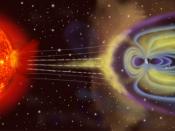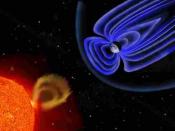Containing over 99.8% of the solar systems matter, the sun is the source of life on Earth.
The Influence of the Sun's radiation on life on Earth:
The sun's radiation is divided into 3 categories.
1. White light:-which fuels processes such as photosynthesis, which is crucial for the life of plants.
2. Infra red:-which produces heat, this provides warmth for Earth's inhabitants.
-and it also is the component which evaporates water, making it essential for the formation of clouds, and in turn the production of rain.
3. UV radiation:-which is sub-divided into UVA, UVB and UVC.
UVA: changes fats to vitamin D and is essential for deposition of calcium in bones.
UVB & UVC: are harmful and cause skin cancer.
The formula C = f û where "C" is a consonant means the smaller the wave length the higher the frequency and according to this formula: E = h f the higher the frequency the higher the Energy it possesses.
So since UVC has the shortest wave length, it therefore has the highest energy which means it can penetrate skin and cause mutations in chromosomes and genes.
Although the electromagnetic radiation that comes from the sun in the form of visible and infrared light is life-supporting and environmentally friendly, the other form of the spectrum have damaging effects on life and the surrounding environment.
The Solar Wind:
Solar wind is an outflow of low-density plasma from the corona of the sun. Solar wind has a speed of 400-500 km/h. At these speeds solar wind takes 3 to 4 days to reach the Earth. Near the Earth the solar wind has a density of approx. 5 protons and 5 electrons per cubic cm with some helium and heavier ions. The velocity of the particles gives them a temperature of between...


